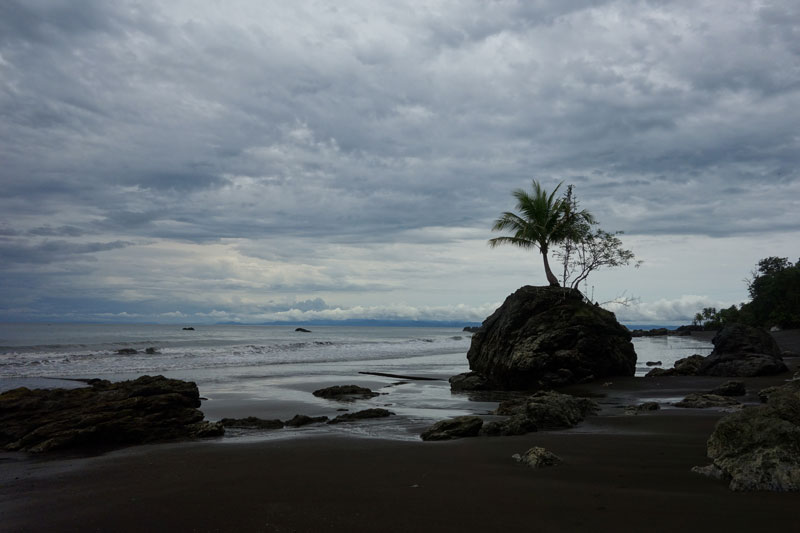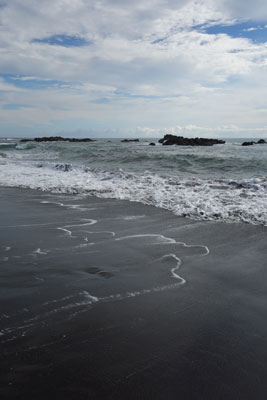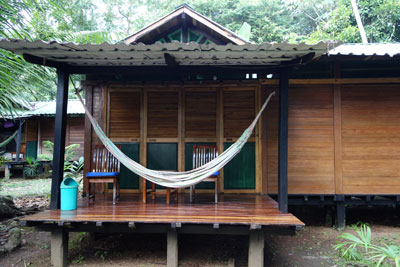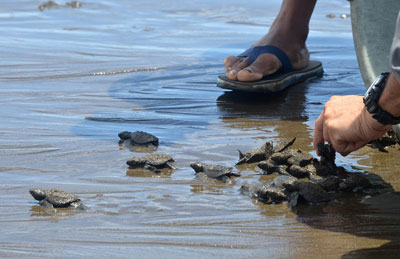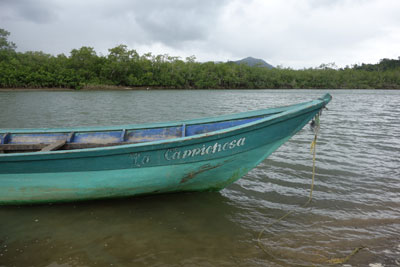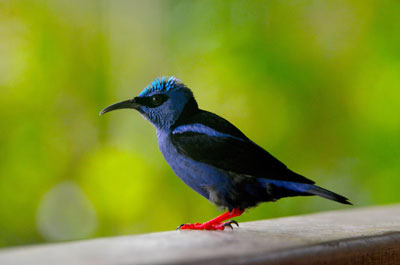Interacting with nature on an ecotour of Colombia
This article appears on page 6 of the March 2014 issue.
by Arthur Hanna, Contributing Editor
As I boarded my flight from New York’s JFK to Medellín, Colombia, little did I know what fantastic experiences would be in store for me.
Getting there
The flight on Avianca was an efficient, 5½-hour affair. Since the local time in Medellín was only an hour off Eastern Daylight Time, my jet lag was minimal.
As we began our descent and the plane emerged from the clouds, Medellín’s verdant, mountainous topography came into view. Like the contents of a grand terrarium, the ultragreen undulating hills with their patchwork of farmhouses flowed between towering mountains.
Medellín’s modern José María Córdova International Airport is situated far from the city, and in no time my cab was cruising along the back roads from the Rionegro area toward the center of the city. We crested the lip of the Aburrá Valley, and a vista of the entire valley opened up below us, exposing a thicket of nearly identical high-rises growing like crystals out of the mountainsides.
After traveling down the face of the mountain on some vertigo-inducing switchbacks, we ended up at the luxurious InterContinental Medellín hotel. I retired early in anticipation of my morning flight to Bahía Solano from the domestic airport located within the city.
Bahía Solano
From the airport in Bahía Solano, we boarded a four-wheel-drive truck and began the drive to our lodge. I had imagined that the 45-minute drive would have us speeding along a paved road, but in reality we moved at the pace of a brisk walk, dodging massive potholes.
One thing about an ecotourism trip like this one — if you have any sort of motion sickness, you will want to be prepared or, perhaps, reconsider.
Our Land Rover eventually lurched onto a gray beach and stopped in front of our first ecolodge, El Almejal. Situated right on the beach, the lodge had 12 cabanas plus a main building, where we took our meals. (The price of COP220,000, or $111, per person per night includes three meals per day.)
The food at Almejal was wonderful and included many traditional Colombian dishes. On our first night, I tried a delicious, spicy, hearty soup called sancocho, which included fish and slices of plantain.
After lunch, Bernardo, the owner, gave us a tour of the grounds. The back of the Almejal has an extensive herb garden, and their composting program mitigates the site’s environmental impact. Since it does not get cold in the winter, they are able to grow crops year-round.
A note about the cabanas on this trip — all had running water, toilets and showers. However, hot water was not on the agenda. A cold shower was mighty refreshing in the late afternoon, but in the mornings it was rather unpleasant. Needless to say, we all got in the habit of showering in the afternoon heat.
Going birding
I rose to the sounds of the rushing stream next to my cabin, birdcalls and the far-off roar of the ocean. A leisurely breakfast in the Almejal’s dining room included a view of the beach.
While we munched on our eggs and arepas (flatbreads), a variety of birds had emerged from the trees to feast on the bananas the staff had placed on a pedestal in the lodge’s courtyard.
Donning rain boots, we boarded a colorful chiva (bus) and set off down the beach toward El Valle. It was a quick ride to the town, part of which was on the other side of the wide river.
On foot, we crossed an old, cable-stayed bridge that was only 20 feet or so above the water. One habit I picked up early on was to watch my feet when walking, as, often, parts of bridges and walkways were missing.
As the trail began to leave the village, the canopy covered us and the wide trail became muddier. The sounds of animals, which before had been only a far-off buzz, became the focus of my attention.
Our birding guide had recorded the sounds of many of the region’s birds on his phone and would play them back to let us know what kind of bird was making each sound. Often he would locate a bird by hearing alone, then plant the telescope in the mud to zoom in on the elusive bird far away in the trees.
The birds that were most recognizable in the forest belonged to the oropendola family, which encompasses a few species of birds with gold (in Spanish, “oro”) tails that weave pendulum-style nests in trees. We passed many trees in the jungle that were festooned with pendulous nests swinging to and fro hundreds of feet in the air.
Some of the birds were very beautiful, but I quickly abandoned the idea of photographing them, as it would take a massive telephoto lens to get any close-ups. In a way, that really enhanced my appreciation of the birds, knowing that at any second the bird I was studying in the telescope might flit away.
As we tromped through the mud, listening ever more intently to the birdcalls all around us, we eventually reached a fork in the trail and chose the path that led to the beach.
To the turtles
As the wet underbrush and canopy slowly unraveled, the sun began to shine through once more and the roar of the ocean was palpable.
We emerged from the forest into the courtyard of the turtle-preservation complex. The pleasant, soft-spoken volunteer at the facility led us up to a black tub filled with sand. At first I wasn’t sure what I was looking at, but soon I noticed that the sand was writhing with hundreds of baby turtles. With calm efficiency, the volunteer carried the tub out to the sun-washed beach.
As the tub was turned on its side, the first tiny turtles came out. We were all standing in the surf with the small waves rolling in as the hundreds of turtles began their dogged trek into the water. We couldn’t move for fear of stepping on one of the babies.
Even though they were so small, they all seemed to know what to do. No matter how many little waves washed them up the beach, they would turn and start paddling with their minuscule flippers once more.
Afterward, we took a long walk back along the beach, which was crowded with thousands of little crabs that scurried every which way as our group passed.
Later that day, a guide led us up into the mountains and jungle above the lodge. As we followed the path around a stream that flowed out of the mountains, our guide told us about the unique plants of the Colombian rainforest.
On to El Cantil
In the morning, we had a light breakfast before beginning our trip via speedboat to Nuquí. Each of us could take only a backpack’s worth of luggage for the next three nights, so I threw a few necessities into my waterproof bag and waded into the ocean to hop into the boat.
On the ride over, the sky darkened and rain poured down on us. It wasn’t terribly unpleasant, since it was warm out, but I could feel the rain hitting me hard even through my jacket.
For the boat trips on this tour, our luggage was usually wrapped in a large black plastic bag for protection from the surf and rain, but I had taken along a waterproof backpack from the bag maker Chrome that proved invaluable for protecting my camera, clothes and documents while still allowing access to them.
Another sundry that really helped was the heavy-duty plastic bags I purchased at REI, which were perfectly sized for phones, passports and other essentials.
From the moment we arrived, Nuquí felt very inviting. The town certainly wasn’t crowded, but people were out in the streets going about their daily business, creating a sense of activity which had been missing in El Valle.
Our guides were always quick to underscore their connections to the locals of the Chocó region, explaining to us that they all were “paísas,” something that translated loosely as “countrymen.” Still, as we strolled through sunny Nuquí, there appeared to be some curiosity among the locals as to exactly what we were doing there.
After our walk around Nuquí, we went back to the dock and waited with two very young military officers for our speedboat. The lancha arrived and we loaded our belongings.
As we pulled into El Cantil Ecolodge, it felt like we had found a lodge at the end of the world.
Soon after we arrived, one of the guests saw the spout of a whale. We hurried over to the dock and boarded kayaks to paddle out and investigate, but we never saw any more.
A relaxing day
On our second day at El Cantil (COP1,400,000, or $704, per person for four nights, including meals and tours), we rose early and had our breakfast at the high dining room overlooking the ocean. Planned for that day was a walk along the beach to Termales, a town containing thermal baths.
When we departed the lodge, a light rain was coming down. The climate was very wet, so my waterproof jacket came in handy. After a few days of touring Colombia, I noticed that, usually, it would rain heavily at night and in the early morning but would clear up in the afternoon.
The path to Termales hugged the coast as it wound through the edge of the lush jungle, which was filled with fruit growing wild. Our guide picked a fresh starfruit for us to try straight from the bush.
It wasn’t long before we began to see the first few houses of the sleepy little town, which consisted of maybe 20 houses in total. Termales was surprisingly beautiful. There were huge flowering bushes lining the earthen main street of the town.
We continued up a path that led inland toward the hills, eventually stumbling upon the thermal baths complex. It looked brand new and incredibly modern in comparison to the surrounding countryside. An elevated open-air dining room (not in service when we were there) looked over the swimming-pool-sized baths, the sides of which were concrete, with natural rock and the thermal vent below.
The water wasn’t hot like that in a hot tub, which meant that one could relax in it for quite a while. The sounds of the creek rushing by, the tree branches rustling overhead and the faint bubbling of the thermal spring were enough to induce a deep relaxation.
A massive, beautiful, cerulean-blue morpho butterfly fluttered up past the creek and wafted on the breeze out into the forest beyond, heightening the tranquility of the moment.
Fully relaxed, we boarded our kayaks for a paddle over to the nearby Rio Cambiado, a river that actually changes course each time the tide comes in. We glided through fantastic foliage, eventually reaching a section too shallow to traverse. We let the current take us back out into the ocean, then paddled around a seastack to get back to the lodge.
The food at El Cantil was magnificent. I loved the fried yucca strips and the various sauces that adorned the local fish we were served: albacore tuna and a fish called sierra.
Parque Nacional Natural de Utría
We departed El Cantil in the morning and made our way by boat to the lodge on the beach at the visitors’ center of Parque Nacional Natural de Utría. Before we left, we kayaked around the long inlet that faced the park. The park staff had told us that whales liked to give birth in this protected stretch of ocean.
A floating platform had been placed over a small sunken ship, so we moored our kayaks to it and snorkeled around the wreck to see the various fish that now called the wreck home.
Before the sun went down, a guide with the park led us along an elevated walkway that threaded its way through the endless wetlands. In some parts, the walkway was just at the height of the water, so it felt like we were walking across lakes while we learned about each plant and animal.
Back at the lodge (COP192,000 per person per night, including meals and outdoor activities), there were jars full of many exotic and poisonous species, such as sea snakes and frogs, that are endemic to the area. After seeing this display, I felt foolish for brazenly swimming around in the inlet across from the lodge.
At night, the sound of the jungle outside was deafening — nature’s equivalent of rush-hour traffic. There was an astonishing variety of frog noises, some of which were very loud.
Whales!
We woke up the next day primed for whale-watching (COP80,000 per person). On all of our other boat trips we hadn’t seen a single whale, so I was cautiously optimistic.
After about a half hour on the water, we saw our first spout. It was fantastic to see the spouts of two humpback whales, which we followed for 20 minutes or so. Finally, we saw one whale’s flukes splash as it dived.
As we were waiting to see another spout, we heard a strange sound. After a few moments, the pilot turned off the boat’s motor and we all looked at each other quizzically. I had never imagined that it would be audible above the water, but the ebb and flow of whale song was clear as day.
Eventually, the whales either departed or stopped singing and we continued along, even seeing a big sea turtle swimming along as we motored back to the port.
An exciting ending
Even though I still had a full 18 hours until my flight back to the States, our morning back in Bahía Solano was really the end of our trip. Eating breakfast in Alemejal’s open-air dining room, one of my companions remarked, “It’s funny. When we first got here this place was so different, but now it’s like we’re leaving our home.”
As we waited at a café across from the Bahía Solano airport for our flight to Medellín, it occurred to me that I didn’t need to keep checking my watch, as ours was the only flight arriving.
Once we were back in Medellín, we boarded a bus for a tour of the city. I was expecting to visit the Plaza Botero and the Museo de Antioquia, but, in keeping with the ecological theme of the trip, our bus wound around and up the mountainous terrain of the city toward Arví ecotourism park.
The nearly-40-acre park is divided into sections managed by different companies. We first visited Hotel y Parque Ecológico Piedras Blancas, situated on a cliff overlooking a lake.
At the hotel’s restaurant, I had a wonderful example of a traditional Colombian meal, the Antioquia variety of bandeja paisa, a very hearty dish that usually includes rice, beans, chicharrón (fried pig skin), fried egg, chorizo and an arepa. I also had blackberry juice, which I’d developed a taste for on this trip.
Then we went on an exhilarating zip-line ride over the lake and explored the grounds. There was a small museum with exhibits on the flora and fauna of the region, including specimens of the morpho butterfly we’d seen earlier, as well as some living insect specimens.
The next stop was at a section of the park managed by a company called Confama. The main attraction at this park was an adventure route that consisted of structures strung high up in the trees.
We were strapped into safety harnesses and given a crash course in climbing, then we set about crossing from tree to tree. Some of the crossings were by zip line, while others tested each participant’s balance. I never fell off, avoiding having to be caught by the safety wire, but those who are wary of heights would do well to only do the children’s course.
After we had finished climbing almost to the top of the canopy, our instructor asked, “Do you want to go for a long zip line?”
Fifteen minutes later, I was climbing up an incredibly long ladder to the top of a tree at least five or six stories in the air.
A line left the tree and vanished into the distance across a valley dotted with pine trees. I could barely see the other platform far, far away. I clipped myself to the line and pushed off.
Underneath me, the valley unfolded. I was flying about 50 feet above the pine trees. The only building visible was a tiny farmhouse perched on a far-off ridge.
Soon, I thwacked into the pad at the other end, grabbing onto the handle. It was a wonderful afternoon of fun up in the trees.
There was something magical about this trip. It was just the right mix of relaxation and excitement. I was left wanting to see much more of Colombia.
Arthur Hanna was a guest of Proexport Colombia (Calle 28 No 13A-15 Floor 35-36, Bogota, Colombia; phone +571 5600100).

